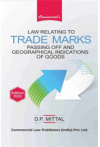
- Author(s): D.P. Mittal
- Publisher: Commercial Law Publishers (India) Pvt Ltd
- Edition: Ed 2022
- ISBN 13 9789356030725
- Approx. Pages 1156 + Contents
- Format Hardbound
- Approx. Product Size 24 x 16 cms
- Delivery Time 3-5 working days (within Kerala & South India) (Others 7-9 days)
- Shipping Charge Extra (see Shopping Cart)
............................................................................................
Description
The book deals with Law of Trade Marks, Common Law of Passing Off and Law of Geographical Indications of Goods. Trade Marks Act, 1999 provides protection for the marks registered thereunder. Passing off action is an action in common law which is essentially the protection of goodwill and reputation which the person has created by virtue of carrying out business activities under a particular name and style or under a brand name, for that matter the said action is an action in deceit which is to prevent any misrepresentation caused amongst public. The Geographical Indications of Goods Act, 1999 deals with registration of geographical indications relating to goods, to protect the interests of the producers of such goods and the consumers from the deception exercised by unauthorized persons. It is not registered as a trade mark. It is a public property. The object of trademark law is to deal with precise nature of the rights which a person can acquire in respect of a trademark, the mode of acquisition of such rights, the method of transfer of those rights to others, the precise nature of infringement of such rights, the procedure for enforcement of those rights and the remedies available in respect thereof. This branch of Commercial Law has undergone a change from time to time in tune with changing patterns of business methods and practices. Even the very concepts of a trademark and its functions have changed. In India, the law now is governed by the Trade Marks Act, 1999 which replaced the Trade & Merchandise Marks Act, 1958 to comply with the World Trade Organization's TRIPS (Trade-related aspects of intellectual property rights) obligation. The 1999 Act extended the scope of "trade mark", "mark", "collective mark", "goods", "registered trade mark", "permitted use", to be in tune with international practices; widened the scope of infringement of trade marks; broadened the concept of criminality; provided protection to well-known trade mark, i.e., a mark used over particular goods or services that has gained sufficient recognition among the consumers, which need not be registered in India. A new chapter was added in 2010 on protection of trade marks through international registration under the Madrid Protocol.
.........................................................................................
Contents
Chapter 1 : Trade Mark - Features and historical prespective
Chapter 2 : Trade Mark - What it means
Chapter 3 : Mark
Chapter 4 : Domain Name and Cybersquatting
Chapter 5 : Goods and Services in the Course of Trade
Chapter 6 : Brand and Logo
Chapter 7 : Generic Branding
Chapter 8 : Registrability
Chapter 9 : Well Known Trade Marks
Chapter 10 : Trade Mark - Use Protected by Patent Law and Copyright Law
Chapter 11 : Registration - Procedure
Chapter 12 : Registration - Opposition
Chapter 13 : Registration - Duration, Removal and Restoration
Chapter 14 : Registration - Collective Marks
Chapter 15 : Registration - Certification Trade Mark
Chapter 16 : Effect of Registration
Chapter 17 : Law of Infringement
Chapter 18 : Passing off
Chapter 19 : Infringement and Passing off - Injunctive Relief
Chapter 20 : Groundless Threat
Chapter 21 : Assignment and Transmission
Chapter 22 : Trade Mark - Use and Registered users
Chapter 23 : Register of Trade Mark - Rectification and Cancellation
Chapter 24 : International Registration - Madrid Protocol
Chapter 25 : powers of Register
Chapter 26 : Appeal
Chapter 27 : Penalty
Chapter 28 : Offences by Companies
Chapter 29 : Prosecution - Congnizance of Offence
Chapter 30 : Quashing Criminal Proceedings
Chapter 31 : Protection of action taken in good faith
Chapter 32 : Geographical Indications - An introduction
Chapter 33 : Geographical Indications Act - an overview
Chapter 34 : Geographical Indications - what it means
Chapter 35 : Geographical Indications - Registrability
Chapter 36 : Geographical Indications - Registration Effect
Appendices
............................................................................................
Author Details
D.P.Mittal
